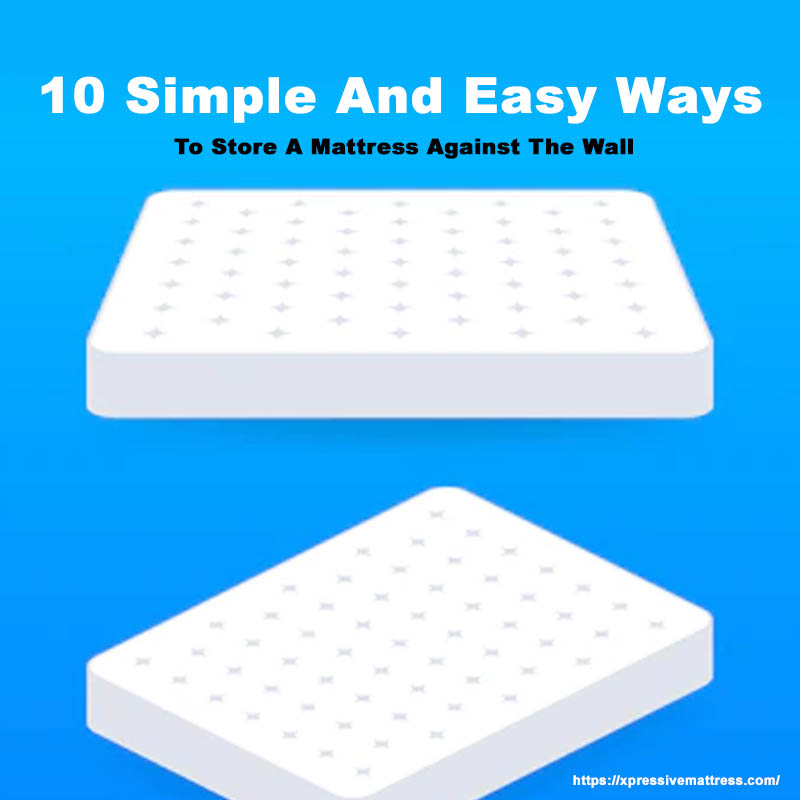Fixing a bump in your mattress can be an easy and cost-effective way to improve your sleep quality each night.
It’s important to take care of any bumps or lumps that may have developed over time, as they could cause discomfort while sleeping.
Here are some tips on how to fix a bump in your mattress:
- Check for loose springs – If one spring sticks out more than others, it might need tightening.
- Flip the Mattress – Flipping the mattress regularly will help even wear and tear.
- Add Supportive Layers – Support layers such as memory foam pads or egg crate mattresses can provide extra cushioning.
- Replace Your Mattress Regularly – Replacing old mattresses with new ones every few years helps keep them from developing deep depressions, which lead to uncomfortable bumps.
These steps should ensure you’re getting good restful nights without having too many issues due to lumpy beds!
What Causes Bumps In Mattresses?
Bumps in mattresses are caused by a variety of factors.
The most common causes include
- Age.
- Wear and tear.
- Improper support or foundation.
- Poor quality materials used to make the mattress and incorrect cleaning methods.
Age
Over time your mattress will naturally start to sag due to regular use, which can cause bumps on its surface.
This is especially true for older models that have been around for many years without being replaced.
Wear and Tear
Regularly sleeping on one side of the bed more than another can create an unevenness across it, leading to lumps forming over time and any accidental damage such as spills or tears from pets/children playing too rough with it!
Poor Support Or Foundation
Suppose you don’t provide adequate support underneath your mattress (such as using slats instead of box springs). In that case, this could lead to sagging areas where lumpy spots form easily when pressure is applied during sleep sessions each night.
Poor Quality Materials Used To Make Mattress
Low-quality foam layers inside some cheaper beds may not be able to withstand long periods of usage before they begin breaking down into smaller pieces causing uncomfortable ridges along their surfaces while also creating potential health hazards if inhaled through dust particles released off them regularly throughout the day/night cycles Incorrect Cleaning Methods– Using harsh chemicals like bleach when trying clean stains out from fabric covers might end up damaging material fibers making them weaker thus resulting in bumpier textures after drying process has finished taking place.
What Are The Signs Of A Bumpy Mattress?
A bumpy mattress is a sign that your bed needs to be replaced.
Signs of a lumpy or uneven surface include lumps, dips, and ridges in the mattress.
Sagging areas where you can feel springs poking through.
Indentations from sleeping on one side for too long.
And an overall feeling of discomfort when lying down.
Other signs may include waking up with aches and pains due to lack of support, difficulty getting comfortable at night, tossing and turning throughout the night trying to find relief from pressure points caused by bumps in the mattress.
It’s important for comfort and health reasons – if left unchecked, it could lead to back pain over time!
How To Identify The Source Of The Bump?
Identifying the source of a bump can be tricky.
Here are some tips to help you out:
- Look for signs that something has been bumped into, such as scratches or dents on walls and furniture.
- Check if there is any debris around the area where the bump occurred.
- Listen carefully – sometimes bumps will make noise when they happen, which may give clues about what caused it.
- Feel around – use your hands to feel along surfaces in case anything was knocked over during impact.
- Examine objects nearby – look at items close by, like bookshelves and chairs. These could have been moved due to an impact from another object hitting them first.
- Ask questions– ask people present at the time of the incident whether they saw or heard anything unusual before/afterward that might provide more information about the cause of the bumping sound.
- Investigate further – take pictures and videos with your phone, so you can review them later if needed; this way, you’ll get better evidence regarding possible sources causing damage.
By following these steps, identifying the source behind a mysterious ‘bump’ won’t seem too daunting!
How To Flatten A Bump In A Mattress?
If you have a bump in your mattress, there are several ways to flatten it.
- Try flipping the mattress over and sleeping on the other side for a few nights. This can redistribute weight more evenly across both sides of the bed and may reduce or eliminate any bumps that were present before.
- If this doesn’t work, consider adding an extra layer of padding, such as memory foam or latex foam, between your existing mattress layers. These materials will provide additional cushioning, which should help even out lumps in the surface area.
- Finally, if all else fails, purchase another new top layer (or “topper”) specifically designed to smooth out uneven surfaces – they come with different levels of firmness, so make sure you choose one that best suits your needs!
In summary:
- Flip Mattress Over – Redistributes Weight and May Reduce Bumpiness
- Add Extra Padding Layer – Memory Foam/Latex Foam Cushioning Helps Even Out Lumps
- Purchase New Top-Layer Topper – Different Levels Of Firmness Available
What Are The Home Remedies To Fix A Bumpy Mattress?
There are several home remedies to fix a bumpy mattress.
- You can rotate the mattress every few months so it wears evenly and doesn’t develop lumps or bumps in one area.
- If your bed has springs inside, check for any broken ones and replace them as needed. This will help keep the surface even.
- Add an extra layer of padding on tops, such as memory foam or egg crate foam, which helps distribute weight more evenly across the entire sleeping surface.
- Finally, use a firm board underneath your box spring to provide additional support and prevent sagging over time – this is especially important for older mattresses with worn-out coils!
These simple steps should help ensure that your sleep environment remains comfortable without buying a new mattress immediately!
What Are The Professional Methods To Fix A Bumpy Mattress?
There are several professional methods to fix a bumpy mattress.
- You can rotate the mattress regularly. This will help even out any lumps or bumps that have formed over time.
- If your mattress is too soft and lumpy due to wear and tear, adding an extra layer of padding may be beneficial in providing more support for your body while sleeping.
- A foam pad on top of the existing bedding material can also provide additional cushioning, which helps reduce pressure points when lying on it at night.
- Finally, replacing old springs with new ones could also make all the difference!
All these solutions should improve comfort levels significantly, so don’t hesitate to try them out before investing in a brand-new one!
How To Prevent Future Bumps In Mattresses?
To prevent future bumps in mattresses, there are a few simple steps you can take:
- Rotate your mattress every 3-6 months to ensure even wear and tear on the bed’s surface.
- Use a supportive foundation or box spring that is designed for use with your specific type of mattress.
- Place an appropriate size sheet over the top of your mattress before making it up each time. This will help protect against dirt buildup, which could cause lumps and bumps.
- Vacuum regularly using low suction settings so as not to damage any fabric covering on the bed’s surface – this helps keep dust mites away too!
- Invest in quality pillows that provide adequate sleep support (memory foam works well).
- Avoid jumping or sitting directly onto beds as much as possible, especially if they have springs inside them. These types tend to be more prone than others when it comes to forming indentations from heavy weight being placed upon them suddenly.
- It may lead to unevenness across different areas causing uncomfortable dips where people sleep most often! Finally, ensure all parts, such as legs/feet, are securely attached at regular intervals throughout their lifetime – loose screws.
Wrapping Up: How To Fix Bump In Mattress?
In conclusion, fixing a bump in your mattress is not as difficult or expensive as it may seem.
With the right tools and knowledge, you can easily fix any bumps that have developed over time.
1. Identify what type of material makes up your mattress.
This will determine which repair method to use.
If springs are inside the bedding, they should be tightened with an adjustable wrench or screwdriver if necessary.
For foam mattresses, add more layers until the lump has been flattened out completely – either by using extra paddings such as memory foam sheets or even blankets!
Finally, for air beds, check for leaks before attempting repairs. These types require special attention due to their delicate nature, so always consult a professional when dealing with them!
All-in-all, regardless of the problem, taking care of it yourself could save you money while also giving you peace of mind knowing that everything’s back in order again!



